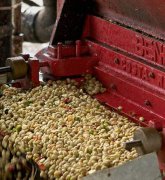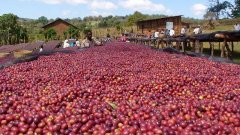Introduction to the Lion King Coffee Bean Flavor Manor of the Sidamoshilsa Cooperative
Sidamo Lion King Solar G1
Variety: native species
Baking degree: shallow baking
Treatment: sun treatment
Grade: G1
Flavor:
Dry aroma: wild ginger, jasmine, honey, wheat, lemon peel aroma
Wet fragrance: sweetness of honey, more floral aromas, aromas of maple syrup, cream, citrus
Sipping: strong fruit tonality, cantaloupe, strawberry, peach, ripe berry and other rich fruit flavor, silky texture, clean and balanced taste, lively, sweet and full-bodied finish.
Country: Ethiopia
Producing area: Sidamo
Processing plant: Sirsa cooperative
Altitude: 1880 m
Sidamo
The coffee flavor of Sidamo is very diverse, and the different soil types, microclimate and countless native coffee species make the coffee produced in each town have obvious differences and characteristics.
The geology of the area is a fertile, well-drained volcanic soil with a depth of nearly two meters and a dark brown or brown surface soil.
The biggest advantage of this place is that the soil fertility is maintained through the circulation of natural organic matter, using the withered leaves or litter of the surrounding trees and the residual roots of plants as natural fertilizer.
Sirsa Cooperative Society
This batch is produced by the Sirsa Cooperative near Dilla town.
The cooperative was founded in 1976 and is currently a member of the SCFCU of the Sidamo Farmers' Cooperative Union.
Introduction to the manor:
The geology of the Sidamo region is a fertile, well-drained volcanic soil with a depth of nearly two meters and a dark brown or brown topsoil. The biggest advantage of this place is that the soil fertility is maintained through the circulation of natural organic matter, using the withered leaves or litter of the surrounding trees and the residual roots of plants as natural fertilizer. The Hilsa Cooperative was founded in 1976 and is located near the city of Dilla town.
Currently a member of the SCFCU of the Sidamo Farmers' Cooperative Union, the Sirsa Cooperative has about 1200 farmers and has its own washing plant. This batch has been screened twice and has excellent performance in flavor.
The Federal Democratic Republic of Ethiopia, commonly known as Ethiopia, is a country located in northeast Africa, formerly known as the people's Democratic Republic of Ethiopia.
It was formerly known as Abyssinia.
Unlike other African countries, Ethiopia maintained its ancient monarchy before the second Italian War (1936-1941) and was not engulfed by the wave of colonialism.
In 1974, Ethiopia abolished the monarchy and became a socialist state after a bloody military coup overthrew Emperor Haile Selassie I Selassie I, who had ruled Ethiopia since the 1930s. It was not until 1991 that Ethiopia ended and abandoned the socialistic political system. The African Union (AU) is headquartered in the country's capital, Addis Ababa.
Ethiopia is the hometown of coffee. It is said that Arabica coffee was discovered by monks in Ethiopia. To this day, Ethiopia still contains about 60 to 7000 unknown coffee varieties. For coffee lovers, Ethiopia is also the best coffee producer in the world.
Geographical introduction: Ethiopia covers an area of 1104300 square kilometers and is located on the vast Ethiopian plateau in eastern Africa. After the independent establishment of Eritrea in May 1993, Ethiopia became a landlocked country. Neighboring countries include Djibouti, Eritrea, Sudan, South Sudan, Kenya and Somalia. The capital is in Addis Ababa. In addition, the Iremi Triangle on the border with Kenya and South Sudan, Ethiopia and South Sudan each claim sovereignty and jurisdiction, which are now under the jurisdiction of Kenya. Area 2/3 of Ethiopia is the Ethiopian Plateau, generally 2500-3000 meters above sea level, with the highest topography among African countries, with the "roof of Africa" in the southeast belonging to the Somali Highlands; the Great Rift Valley runs through the middle of the territory; deserts and semi-deserts account for 28% of the territory. Climate introduction: savanna climate and subtropical forest climate are given priority to, with both mountain and tropical desert climate. The annual precipitation decreases from 1500 mm in the western plateau to 500mm in the northeast and southeast.
Important Notice :
前街咖啡 FrontStreet Coffee has moved to new addredd:
FrontStreet Coffee Address: 315,Donghua East Road,GuangZhou
Tel:020 38364473
- Prev

Yega Xuefei Guji producing area detailed introduction to the classification of Ethiopian coffee producing area
Yega Xuefei Fruit Ding Village washed G1 Alim Bukato small Farmers Variety: Ethiopia ancient excellent original species baking degree: shallow baking method: washing flavor: as soon as it is ground like coffee blossoms and egg blossoms and lemon aromas come to the nostrils, the sweet apricot leads the opening, the sour aromas of white pomelo and lemon flutter in the mouth, and the sweet and sour feeling of yogurt adds layers.
- Next

Introduction of Kaddura Flavor by slow drying and washing treatment of Triumph Manor in St. Augustine, Colombia
St. Augustine Triumph Manor slow drying washing varieties: Kaddura baking degree: shallow baking treatment: slow drying washing treatment flavor: yellow fruit notes, sweet orange, cream toffee, smooth taste, fragrant and sweet! Country: Colombian producing area: St. Augustine Manor, Villa, Colombia: triumphant Manor: altitude: 1870m Colombian Ben
Related
- Detailed explanation of Jadeite planting Land in Panamanian Jadeite Manor introduction to the grading system of Jadeite competitive bidding, Red bid, Green bid and Rose Summer
- Story of Coffee planting in Brenka region of Costa Rica Stonehenge Manor anaerobic heavy honey treatment of flavor mouth
- What's on the barrel of Blue Mountain Coffee beans?
- Can American coffee also pull flowers? How to use hot American style to pull out a good-looking pattern?
- Can you make a cold extract with coffee beans? What is the right proportion for cold-extracted coffee formula?
- Indonesian PWN Gold Mandrine Coffee Origin Features Flavor How to Chong? Mandolin coffee is American.
- A brief introduction to the flavor characteristics of Brazilian yellow bourbon coffee beans
- What is the effect of different water quality on the flavor of cold-extracted coffee? What kind of water is best for brewing coffee?
- Why do you think of Rose Summer whenever you mention Panamanian coffee?
- Introduction to the characteristics of authentic blue mountain coffee bean producing areas? What is the CIB Coffee Authority in Jamaica?

